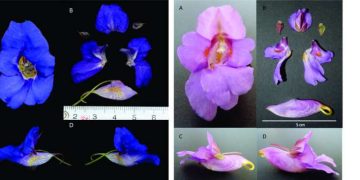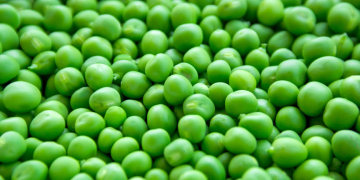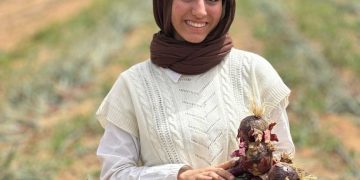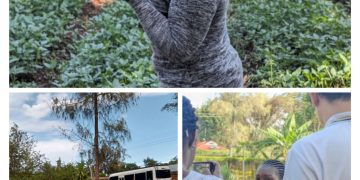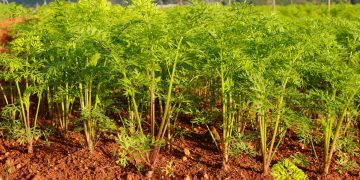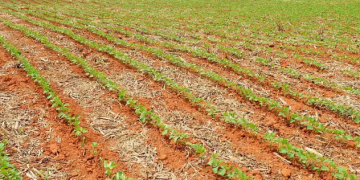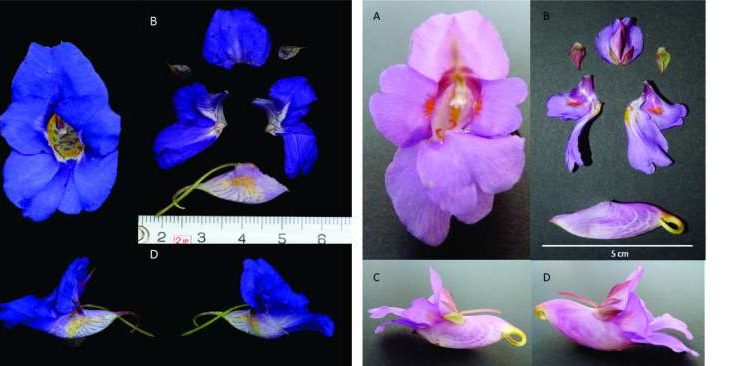Í hjarta dýpsta dals heims vaxa tvær plöntur sem hafa blekkt vísindamenn í áratugi.
Tvær tegundir af „snertu-mig-ekki“ ættkvíslinni (Impatiens) — Blái demanturinn (Impatiens namchabarwensis) og Toothed Busy Lizzie (Impatiens arguta) finnast í hinu afskekkta Tsangpo-gljúfri sem hlykkjast um hæsta tind Austur-Himalajafjalla, fjallið. Namchabarwa.
Bæði plöntur eru prýdd trompetlaga blómum í litrófi og líkindi þeirra urðu til þess að margir vísindamenn trúðu því að þeir tilheyrðu sömu tegundinni.
En sérfræðingarnir höfðu rangt fyrir sér.
Í nýlegri rannsókn sem birt var í Norrænt tímarit um grasafræði, vísindamenn frá Xi'an Jiaotong-Liverpool háskólanum (XJTLU) í Kína og háskólanum í Bonn í Þýskalandi hafa bent á nokkurn mikilvægan mun á plöntunum sem sundra flokkun þeirra og staðfesta að þær séu aðskildar tegundir.
Dr. Bastian Steudel hjá XJTLU, samsvarandi höfundur rannsóknarinnar, segir: „Við stöndum frammi fyrir fjöldaútrýmingu tegunda um allan heim, svo það er nauðsynlegt að þekkja hverja tegund og útbreiðslumynstur þeirra.
„Plöntutegund getur haft blóm með mörgum mismunandi litum; hugsaðu bara um bleikt og hvítt í venjulegri daisy. Það getur því verið krefjandi að greina á milli tegunda með svipuð lögun og búsvæði, eins og I. namchabarwensis og I. arguta. En við höfum nú sýnt að þau eru frævuð af mismunandi skordýrum og hafa meiri mun en áður var talið.
„Niðurstöður okkar eru lítill hluti í tegundagreiningar- og dreifingargátunni, en plöntur eins og I. namchabarwensis, sem finnast aðeins í þröngum búsvæðum, eru oft sérstaklega áhugaverðar fyrir verndaráætlanir.
Vegna óvissu varðandi flokkun þess, greinir rannsóknin frá því að I. namchabarwensis hafi verið vanrækt af núverandi bókmenntum, þar á meðal staðlaðri samantekt allra þekktra plöntutegunda sem finnast í Kína, Flora of China.
Nafn út af fyrir sig
Impatiens namchabarwensis fannst árið 2003 í skoðunarferð til Austur-Himalaya fjallgarðsins og lýst er sem ný tegund árið 2005. Það dreifðist fljótt í vestrænum löndum sem nýjung fyrir garðyrkjumenn sem safna tegundum af „snerti-mig-ekki,“ sérstaklega vegna aðlaðandi lita.
Þar sem dalurinn þar sem hann fannst er líka búsvæði hinnar útbreiddu tegundar I. arguta, töldu margir vísindamenn að plönturnar tvær væru ein tegund.
Dr. Steudel útskýrir: „Á hverju ári eru nýjar tegundir plantna, dýra og örvera auðkenndar. Stundum eru þessar nýju tegundir og leiðbeinandi nöfn þeirra ekki samþykkt af öðrum vísindamönnum. Þeir halda að lífveran tilheyri þegar þekktri tegund og telja nýja nafnið bara valkost. Þetta ferli er kallað samheiti.
„Samheitasetning er mjög mikilvæg; annars myndu allir þekkja tegundina undir öðru nafni og samskipti milli sérfræðinga yrðu mjög erfið.“
Þrátt fyrir gildi samheita eru plönturnar í sumum tilfellum sannarlega mismunandi tegundir og ávinna sér því rétt á nýju nafni. Blái demanturinn (I. namchabarwensis) er slíkt dæmi.
Rannsakendur komust að því að I. namchabarwensis er frævað af haukamýflugum og hefur tilhneigingu til að lifa í tvö til þrjú ár, en I. arguta er valinn af humlum og lifir í átta ár. Þeir benda til þess að munurinn á frævunarefnum sé vegna þess að neðri blómblöð plantnanna snúi í aðeins mismunandi áttir; I. arguta skapar vettvang fyrir blómagesti sína með láréttum krónublöðum, öfugt við laufin sem snúa niður á við á I. namchabarwensis.
Dr. Steudel útskýrir áhrif þess að bera kennsl á þennan mun: „Það væri mjög leitt ef svo falleg tegund eins og I. namchabarwensis væri bundin við að lifa aðeins af í söfnum og vera útdauð í náttúrunni.
„En það væri enn verra ef öll þekking á plöntunni tegundir dó líka út vegna þess að það var rangt flokkað.
